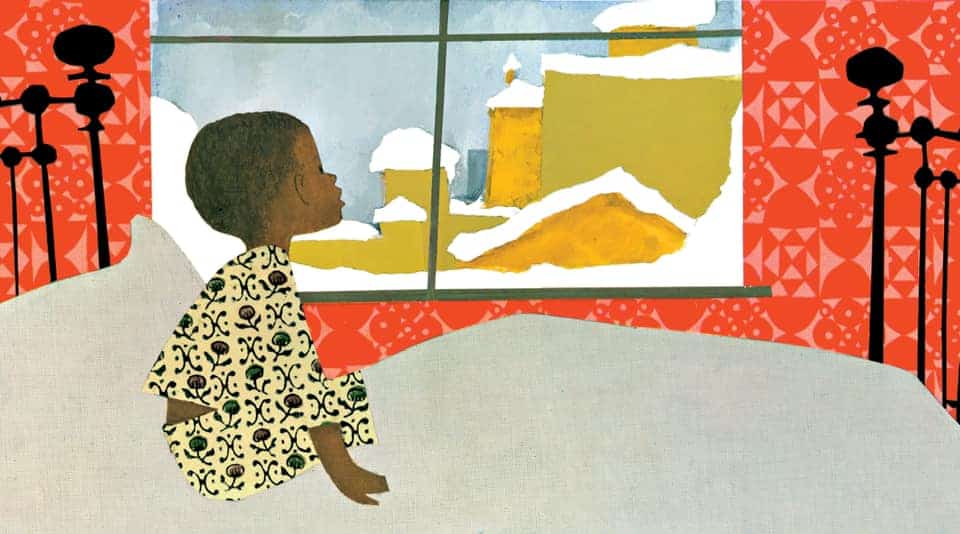The Snowy Day (1962) is a famous American picture book by American author Ezra Jack Keats. The Snowy Day was published in 1962. Assuming the character of Peter was five or six, Peter would be a man of 62 this year, so 2020 is the year to revisit this iconic book.
SETTING OF THE SNOWY DAY
The story itself is a realistic one, though Keats chose collage to create a hyperbolic landscape in which the snowy mountains are impossibly high. This reflects the inner landscape of Peter, who is overwhelmed by the magnificence of the day.
I usually say more about the fictional setting of a picture book, but in this case there’s more to say about the cultural context of America in the midst of a Civil Rights Movement.
The Snowy Day was the first book featuring an African American child to win the Caldecott Medal for excellence in children’s picture books. As a result, the story has faced intense scrutiny.
Keats was inspired to create this story after cutting a magazine strip of photos from a Life magazine issued in 1940. The strip featured a young Black boy. Keats realised how few Black children appeared in picture books, except as ‘token blacks in the background’. He decided to make a Black boy the star of his own story, with young Black readers in mind.
As a result, The Snowy Day was immediately remarkable as a rare picture book starring a Black child, and without the story being about his blackness.
The Snowy Day attracted criticism for this very same reason.
Barbara Bader refers to The Snowy Day as “color-blind” in the sense that it emphasizes similarities between races rather than difference: “In The Snowy Day (1962), Ezra Jack Keats’s joyous celebration of boyhood in winter, the race of lively, bronw-skinned Peter doesn’t matter, is immatierial”. In other words, The Snowy Day emphasizes the universaility of experience across race rather than racial and cultural specificity. It absorbs the African American experience into a universal notion of the human race. As Bob Dixon explains, “[The characters] are black enough, but it’s only skin deep. Nothing would be affected in Keats’ stories if the characters were white. The whole social, political and cultural significance of being black is left out”. Peter wakes up, plays in the snow, is undressed by his mother, takes a bath, and goes to bed. His racial background has virtually no effrect on his activities or on the book, which therefore represents race as inconsequential and unimportant. Even though this might look like progress, it is also a denial of reality. Race remains both consequential and important in the United states, even for children, but The Snowy Day does not acknowledge that.
Reading Children’s Literature: A Critical Introduction by Hintz and Tribunella
Ezra Jack Keats was a Jewish American child, which gave him a few things in common with a Black American child. So, did he stuff anything up?
Well, he did make use of the (sacrificial, subservient) mammy stereotype in his one-page depiction of Peter’s mother.
The following observation applies to any work of art:
Neither the author’s racial background nor the author’s intentions determine or limit readers’ responses to a book, and just because Keats’s goals were benevolent does not mean his work is not a product of its historical context and therefore maekd by race and racial bias.
Reading Children’s Literature: A Critical Introduction by Hintz and Tribunella
STORY STRUCTURE OF THE SNOWY DAY
I could have used the carnivalesque template to break down the structure of this plot, but I feel it’s slightly more like a mythic journey than a carnivalesque adventure.
PARATEXT
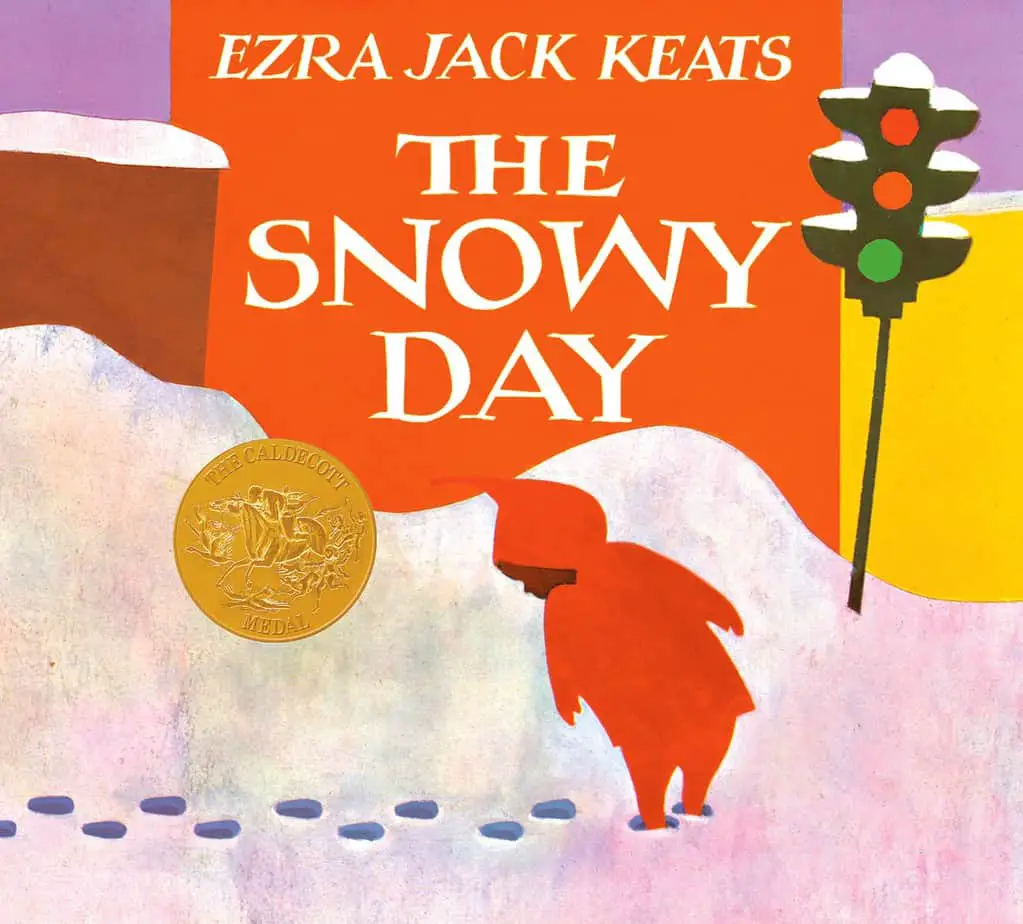
No book has captured the magic and sense of possibility of the first snowfall better than The Snowy Day. Universal in its appeal, the story has become a favorite of millions, as it reveals a child’s wonder at a new world, and the hope of capturing and keeping that wonder forever.
The adventures of a little boy in the city on a very snowy day.
“Keats’s sparse collage illustrations capture the wonder and beauty a snowy day can bring to a small child.”— Barnes & Noble
“Ezra Jack Keats’s classic The Snowy Day, winner of the 1963 Caldecott Medal, pays homage to the wonder and pure pleasure a child experiences when the world is blanketed in snow.”— Publisher’s Weekly
“The book is notable not only for its lovely artwork and tone, but also for its importance as a trailblazer. According to Horn Book magazine, The Snowy Day was “the very first full-color picture book to feature a small black hero”—yet another reason to add this classic to your shelves. It’s as unique and special as a snowflake.” — Amazon
MARKETING COPY
SHORTCOMING
Peter is the Every Child, enchanted by the magical snowy landscape outside. We soon learn that Peter naively thought this magical day could last forever. But he has no moral shortcoming.
The character design of Peter is of interest for his red costume. I assume it’s a snow suit, but it looks very much like Little Red Riding Hood. Picture book illustrators make great use of the small child in red. They stand out beautifully. Other examples of children in red: Wolf In The Snow, Sidewalk Flowers and The Farmer and the Clown.
DESIRE
Peter only wishes to have fun.
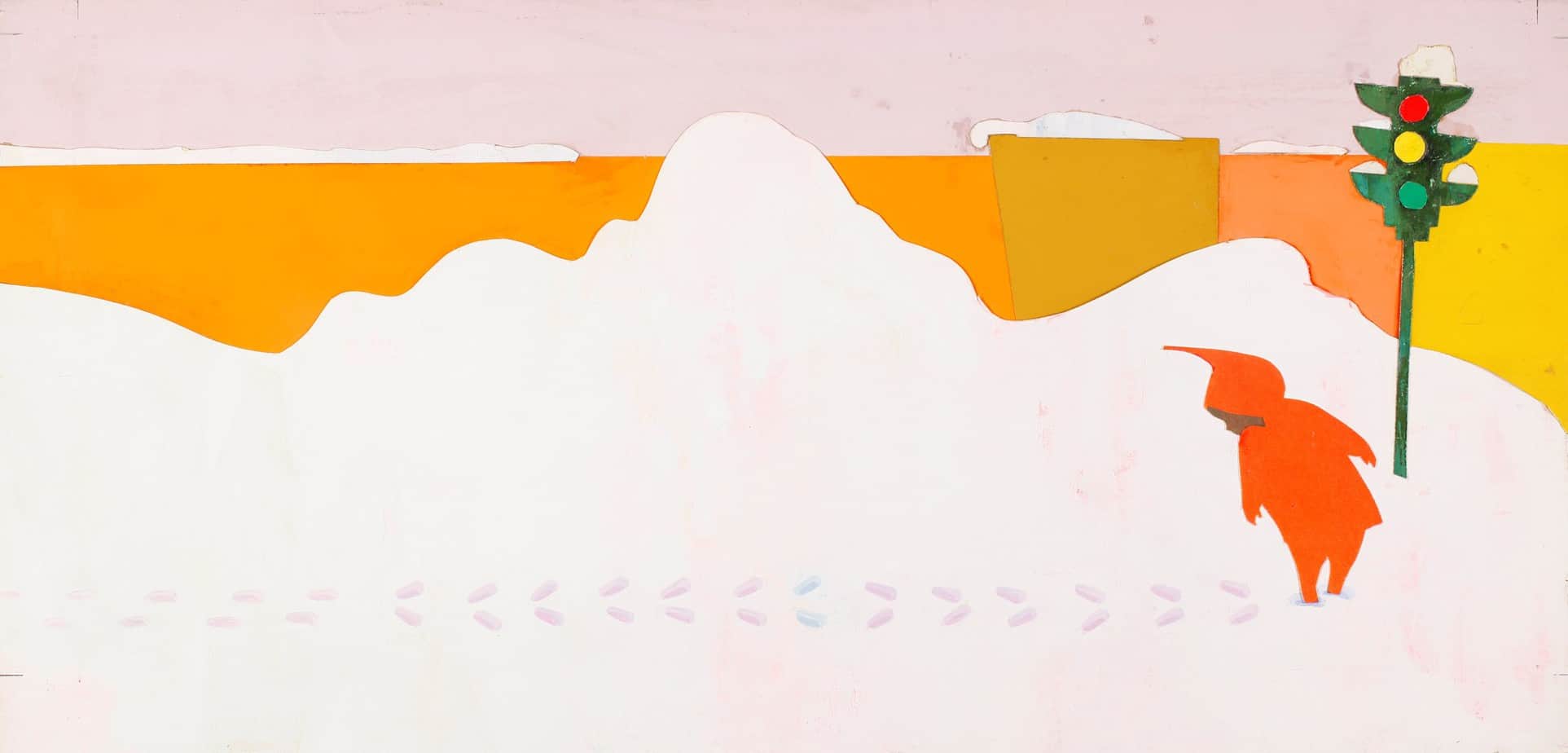
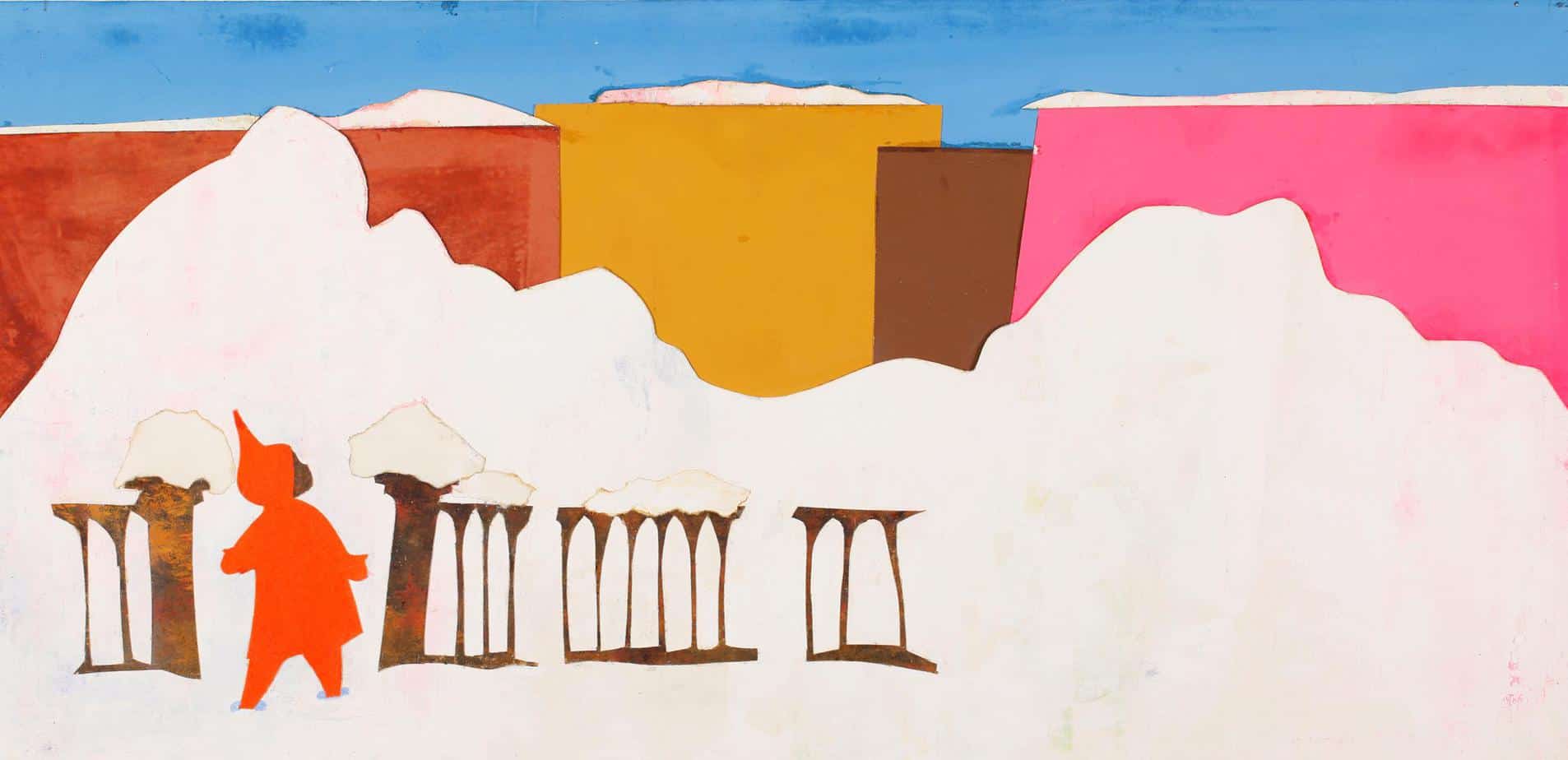
The colour palette in the illustration above reminds of another picture book about a landscape made of ice-cream. The palette itself suggests utopian, childlike fun. The white of the almost looks like ice-cream, don’t you think? (Especially after you’ve seen the illustrations below.)
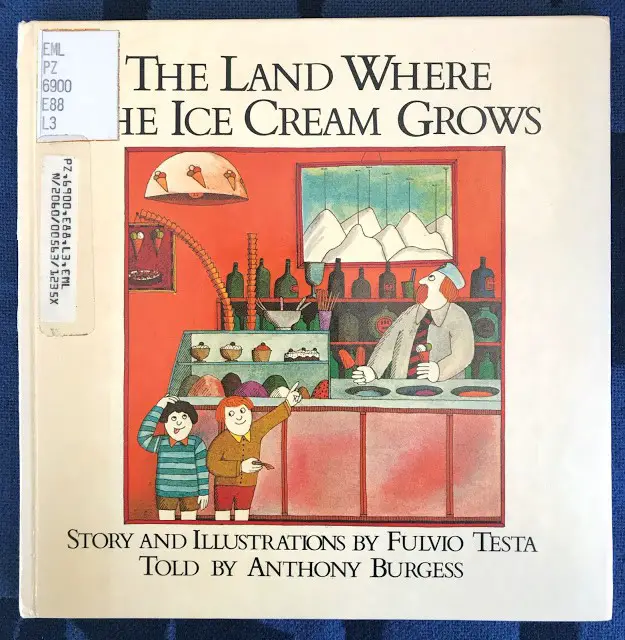
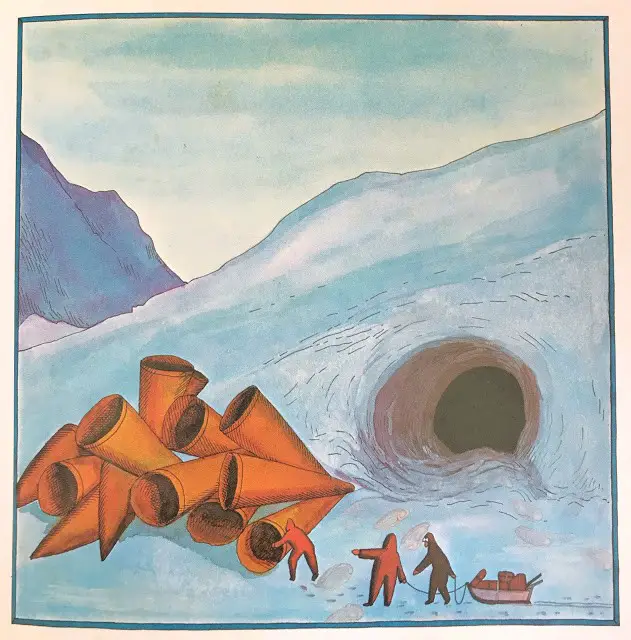
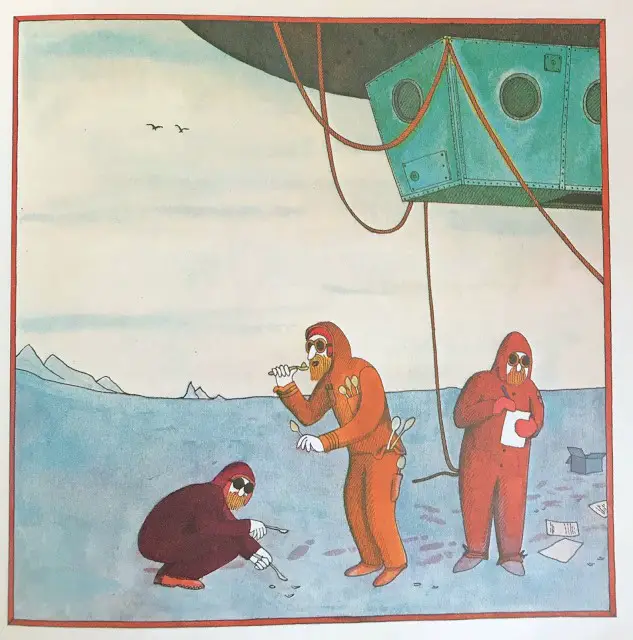
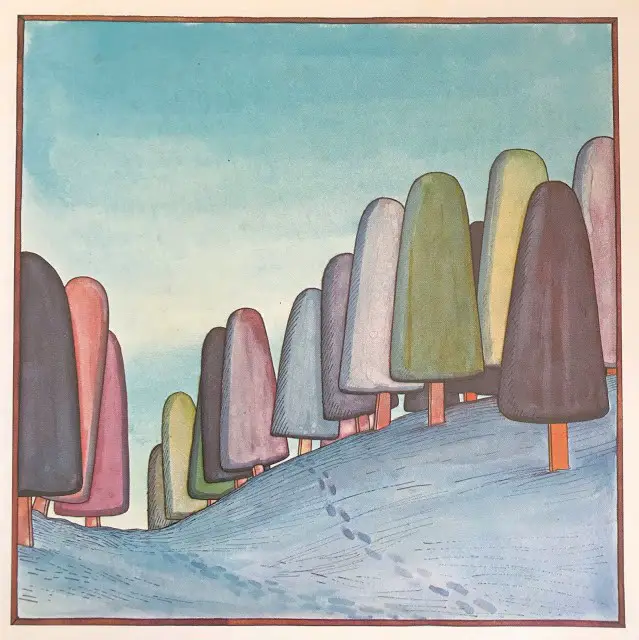
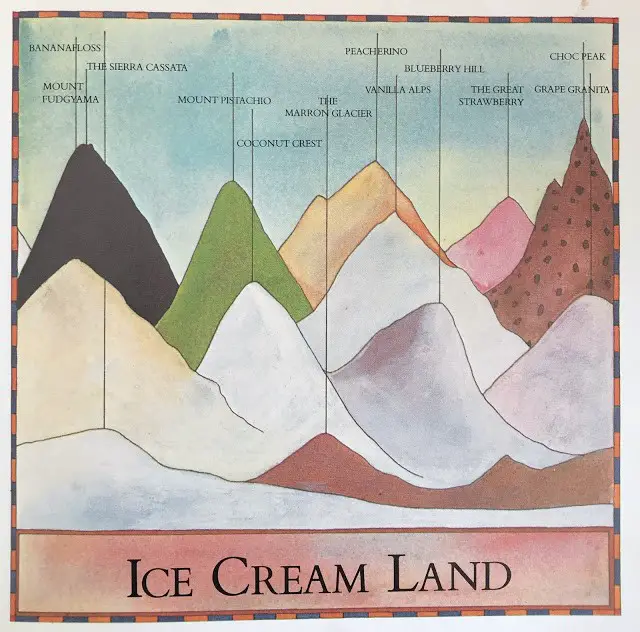
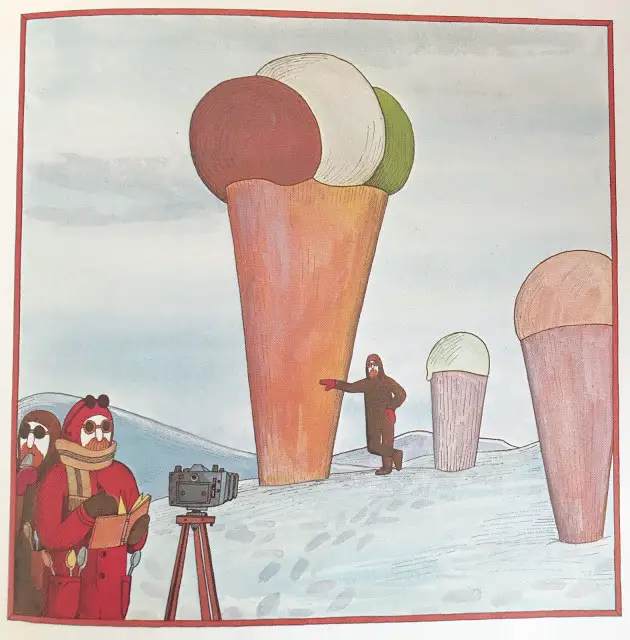
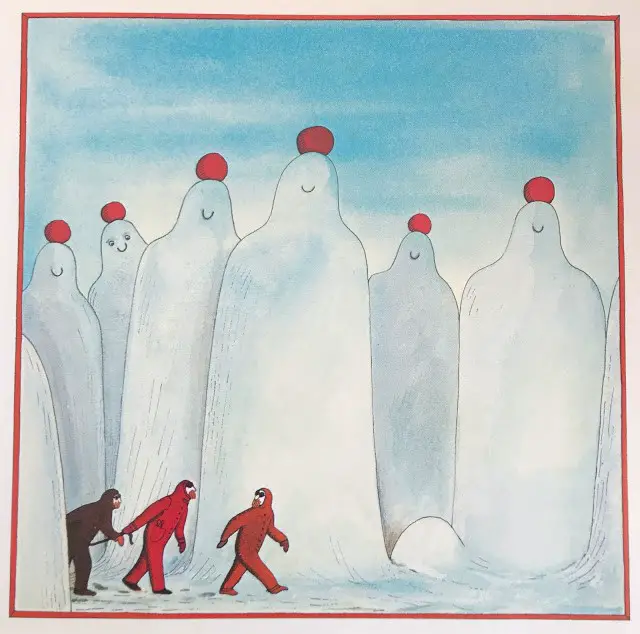
A land filled with something fun, be it snow or ice-cream, is a land of excess, a la The Magic Porridge Pot category of fairytale. Like the peasant of folktale who stumbles upon the ‘Magic Pot’ that keeps on giving, Peter naively thinks this snowy day can last forever.
This is very much how children around that age grapple with time. (ie. They don’t.) After my first day at school I told my parents I’d done school now and wasn’t going back. This is a story I’ve heard many people recount of themselves. As adults we forget that children are like this. We spend months preparing our kids to for their big day at school and completely forget to tell them they’ll be attending every day for the next twelve years of their lives.
OPPONENT
Departing from classic carnivalesque structure there’s no Ally In Fun, at least not until the end, when Peter invites his friend to join him for another day of fun. In the carnivalesque, the Ally in Fun often doubles as the opponent (see The Cat In The Hat, who is fun but also really naughty).
Does Peter have an opponent in this story? Not a human one. But a story nonetheless requires an Opponent proxy if it’s going to work.
I think, for storytelling purposes, the opponent is the snowball. Peter wishes to keep the snowball; the snowball opposes this desire by melting. We can’t ascribe intent to a snowball, but until Peter gets a human playmate, the snowball is the stand-in friend. Here’s the thing about snowballs: They’re a tool for human children to have fun. When we see Peter and the snowball, someone is missing. There’s no one he can throw the snowball at. The existence of that snowball foreshadows the addition of Peter’s friend at the end.
PLAN
Peter plans to keep a hold of this magical day forever by taking a piece of it home with him. The sophisticated reader can guess this isn’t going to work; snowballs tend to melt.
THE BIG STRUGGLE
Peter reaches into his pocket and discovers the snowball has gone. This is preceded by a harrowing dream in which the snow has all melted, replaced by sun.
ANAGNORISIS
When Peter wakes in the morning he realises the snow is still there. That doesn’t function as Anagnorisis, though. The Anagnorisis has to be a revelation about the self, or humankind in general.
By his subsequent actions, we know Peter has realised he must Seize The Day. When he picked up that snowball and put it in his pocket he thought every day would be as fun as this one. That illusion was shattered after the snowball melted, and he learned all the snow outside would eventually melt, too. Peter has achieved a little maturity by realising that although good things never last forever, they do last for a little while, and we must make the most of them.

NEW SITUATION
Peter invites his friend to join him for a second fun day in the snow.
EXTRAPOLATED ENDING
RESONANCE
Kids and families love Ezra Jack Keats’s The Snowy Day so much that they’ve checked it out of the New York Public Library system more than any other book in the NYPL’s 125 years of existence—485,583 times since it was published in 1962. That’s more than The Cat in the Hat, Where the Wild Things Are, Charlotte’s Web, and even Harry Potter and the Sorcerer’s Stone.
The Atlantic, Professor Michelle H. Martin
I read The Snowy Day many times as a child and many more times as an adult, having no idea that Ezra Jack Keats was white… All I knew was that someone somewhere had thought that I, a young black reader, deserved an image of my child in my bedtime stories who looked more like me than the blond-haired, blue-eyed Sallies and Billies who stared out at me from between the covers of the basal readers I read every day at school. And although Keats’s The Snowy Day has been lambasted for tokenism, this author was attempting to do what few others in the early 1960s were: giving black children the chance to see themselves and their experiences reflected positively in the literature they read.
Professor Michelle H. Martin, quoted in Reading Children’s Literature: A Critical Introduction by Hintz and Tribunella
